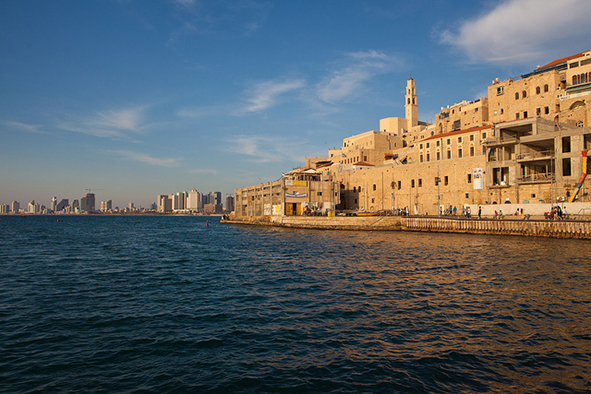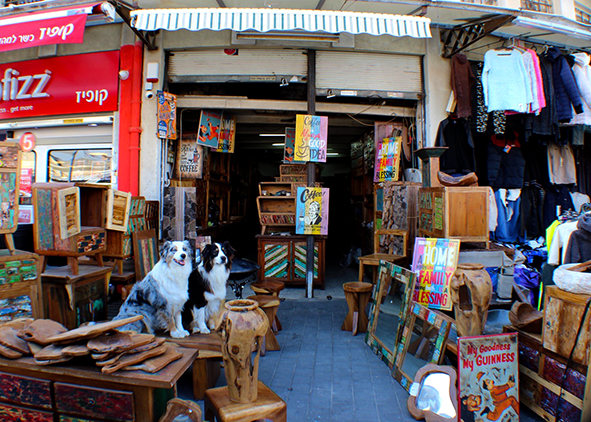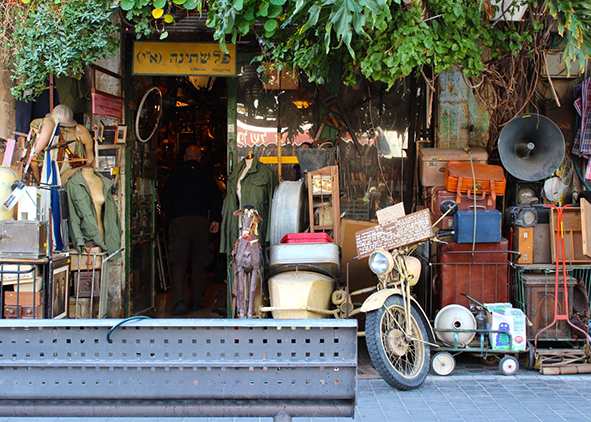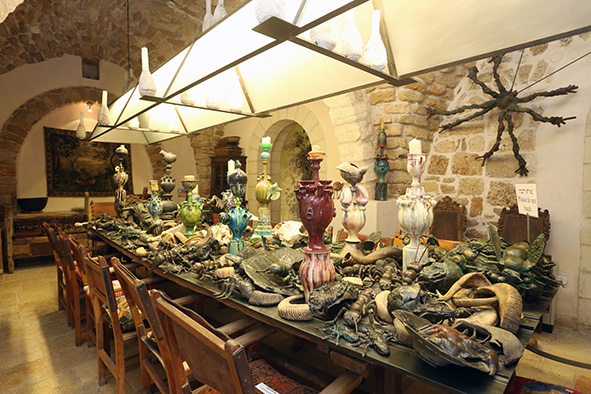Just a few miles from Israel’s second most populous city Tel Aviv lies Jaffa, an ancient gem where life moves at its own pace, just waiting to be discovered.

Jaffa Port (Photo: Dana Friedlander for Israel Ministry of Tourism via Flickr)
According to Greek mythology, a North African queen boasts that her daughter Andromeda is more beautiful than the sea-nyphs that accompany Poseidon, god of the sea. In response, a vengeful Poseidon sends a terrifying sea monster to ravage the queen’s kingdom until she and the king sacrifice their daughter to the monster. To appease Poseidon, Andromeda is then said to have been chained to a rock near the ancient port of Jaffa to await her demise. Ultimately, the hero Perseus rescues her.
Today the ancient city of Jaffa still bears reminders of the myth of Andromeda. A set of rocks outside the port is known as Andromeda’s Rocks, a private venue in Old Jaffa is called Beit Andromeda (Andromeda House) and a controversial luxury-housing development sits atop its namesake Andromeda Hill.
Jaffa has been linked since 1950 to the city of Tel Aviv—where I’ve lived for the last few years—in what is officially Tel Aviv-Yafo (Yafo is Hebrew for Jaffa). But though it’s just south of Tel Aviv, I’ve only visited Jaffa a handful of times. For some reason, it feels much farther away than it actually is. Yael, a longtime resident of Jaffa with whom I spoke on the phone the day before visiting, put it this way: “Jaffa and Tel Aviv are so close, and yet so far when it comes to the cultural gap.”
She’s right. While Tel Aviv is a modern mini metropolis with high-rises and the Israeli stock exchange, Jaffa encompasses an old city and is overflowing with historic architectural gems, much of which date back to the Ottoman Empire. For some, wandering its streets feels a bit like stepping back in time or going on holiday, and I’m thrilled to have an excuse to visit.
More Than Just Bric-a-Brac
It’s a warm Thursday afternoon in January, and I invite my English friend Neil, a freelance editor who also works from home, to join me for some last-minute hummus and a stroll around Jaffa. Since it’s the first blue-skied day of a winter week of rain, I’m correct in my prediction that Neil will be itching to get out of the apartment, and I’m able to convince him to put off his work and join me for a spontaneous afternoon of adventure seeking.
While I wait for him to arrive, I wander around Jaffa’s famous open-air flea market—shuk hapishpeshim—and its surrounding streets and alleyways. Located in what was a 19th century Arab quarter, the area is now known as much for its cafes, bars and restaurants as it is for the antiques, furniture, clothes and jewelry that spill out onto the sidewalk from its plentiful shops.
Today the open-air market is packed with people haggling over shoes, electronics, antiques and all manner of bric-a-brac. A sweater catches my eye at a nearby boutique but so does its price tag and I resist the urge to go in. (Hip Israeli designs don’t come cheap.) I pass by a furniture maker unabashedly singing along to The Red Hot Chili Peppers as he inspects what looks like the beginnings of a chair in his workshop.
I stop to chat with a shop owner who is playing a metal drum among colorful wooden furniture and two friendly dogs. It turns out the instrument is from Switzerland and known as a hang drum, the furniture is recycled from Indonesian fishing boats and the dogs are Australian shepherds named Poli and Chika.
The place doesn’t have a sign or a name. “People just call it Indonesian on the corner,” Gal, a surfer-type, tells me with a smile as a group of trendy teenaged girls stop to eagerly pet his dogs.
Successful Heterogeneity
Neil and I meet at the northern entrance of Jaffa, marked by the Jaffa Clock Tower. Completed in 1903 in parallel with more than 100 other clock towers throughout the Ottoman Empire to commemorate the Sultan Abd al-Hamid II, today the tower, along with what seems like the rest of Jaffa and Tel Aviv, is covered in scaffolding. With construction already underway in Tel Aviv for a new light rail along with new condos and high-rises, and constant renovations of historic buildings in both Tel Aviv and Jaffa, there’s a joke that Tel Aviv’s “national” bird is a crane.
As we walk through Jaffa, admiring buildings like the 19th century Church of Scotland Tabeetha School and neo-gothic St. Anthony’s Parish Church along the way, we reprehend ourselves for not coming here more often.
“One of the things that’s really special about Jaffa is the heterogeneity of the population,” said Yael. “You have it all here. Not only ethnic groups, including Jews and Arabs, but also secular and religious people and young and old and lots of artists making modern and more traditional art.”
In a country that is in a constant state of conflict, it feels uplifting to spend the afternoon enjoying one of Israel’s most beautiful, but also most successfully mixed cities. Though Jaffa is not without its problems, we don’t feel them as we walk along its brick-cobbled sidewalks. Jewish and Arab vendors sell to a mix of customers, Muslim women wearing hijabs walk with their children, and everyone lines up to buy shawarma and baklava. There are older generations, teenagers, tourists and plenty of hipsters. A popular local bar named Anna Loulou is known for its happily mixed culture. DJs play for crowds that are a mix of Arab and Jewish, gay and straight, local and foreign.
In Tel Aviv we may talk a lot about coexistence, but in Jaffa, one way or another, residents are really living it.
Israel’s Best Hummus?
We make our way south to eat at Abu Hassan on Dolphin Street, which is largely considered to be the best hummus in Tel Aviv-Yafo, with some arguing it’s the best hummus in the country. It’s lunchtime and the place is tiny and packed. The custom at hummus joints is to sit wherever you can; so two strangers are condensed at a table to make room for Neil and me. We ask the waiter to bring us his favorite dish and spend no more than two minutes, admiring the press clippings about Abu Hassan covering the walls, before we are served two orders of freshly made hummus topped with olive oil, beans and tomato sauce, and spicy pepper dip on the side. We tear into the stack of fresh pita and quickly wipe our plates clean.
We digest our lunch with a little help from a walk through Jaffa’s port, packed with an eclectic mix of fishing boats. I make a mental note to come back on another day and try the fish ‘n chips stand that fries the morning’s catch, and see a show at the Na Laga’at Theater whose blind-deaf ensemble has been hailed by critics in Israel and abroad.
“There are so many places in terms of art galleries, restaurants, bars, theaters and beaches,” Yael said. “And it’s changing all the time, Jaffa is very dynamic.”
Since Jaffa is known for its art galleries and shops, we decide to visit the home of one of Israel’s most well-known artists, Ilana Goor, which doubles as a public museum. The tiny stone-cobbled alleys of the old city are named after the signs of the Zodiac, and the Ilana Goor museum is on Mazel Dagim Street, which translates into Pisces. There are also bronze reliefs of the zodiac signs decorating the nearby wishing bridge. According to myth, if you touch your sign while making a wish and looking out to sea, your wish will come true.
Located in a restored 18th century building that once housed a soap factory, Ilana’s museum exhibits work by 500 Israeli and international artists alongside her own sculptures, furniture and Judaica. The three-story building includes an outdoor sculpture garden with stunning views of Jaffa and the Mediterranean Sea.
“Ilana has welcomed visitors into her home for 20 years,” the museum docent, Eilon tells us. “And exhibits a mix of pieces inspired by the three monotheistic faiths.” It seems like an appropriate reflection of the neighborhood outside.
We decide to end our day with a coffee and walk up the street past St. Peter’s Church, originally built in 1654, to a nearby restaurant called Aladin. Though it’s technically winter, it’s still a comfortable 18 degrees so we opt to sit outside. The outdoor patio overlooks the water and we can see Tel Aviv’s skyline in the distance blanketed by the late afternoon light. The call to prayer rings out from the minaret of one, and then two nearby mosques, reminding Muslims to pray for the third time today.
Inspired by our amazing day, Neil and I vow to spend more time in Jaffa, and make a date to go to Anna Loulou one evening soon. We’ve heard the owners are moving to Berlin and selling the place. Like everything else within this ancient, but dynamic city, we can never be sure when things will change inside its old walls.


